Are you looking for a unique way to enhance your outdoor space? Garden steps are an attractive and practical addition to any garden or landscape.
Whether you’re looking for decorative staircase design ideas or tips on how to build stairs in your garden, this guide has it all!
This article will discuss the different types of garden steps, the materials you can use to build them, and creative ideas for adding a touch of personality to your garden.
We’ll also provide tips on how to properly construct stairs in your yard so that they last for years to come.
What Materials Can You Use for Garden Steps?
Stone
Stone is a good material for garden steps because it lasts a long time and is easy to take care of. Natural stone like flagstone or sandstone looks natural in the garden.
Wood
Wood is another popular choice for garden staircases, especially if you want to create a rustic look. Pressure-treated wood will last the longest, but it can be pricey. Other inexpensive options include cedar or composite decking boards.
Concrete
Concrete is a great choice for garden steps because it can be shaped and poured into any form.
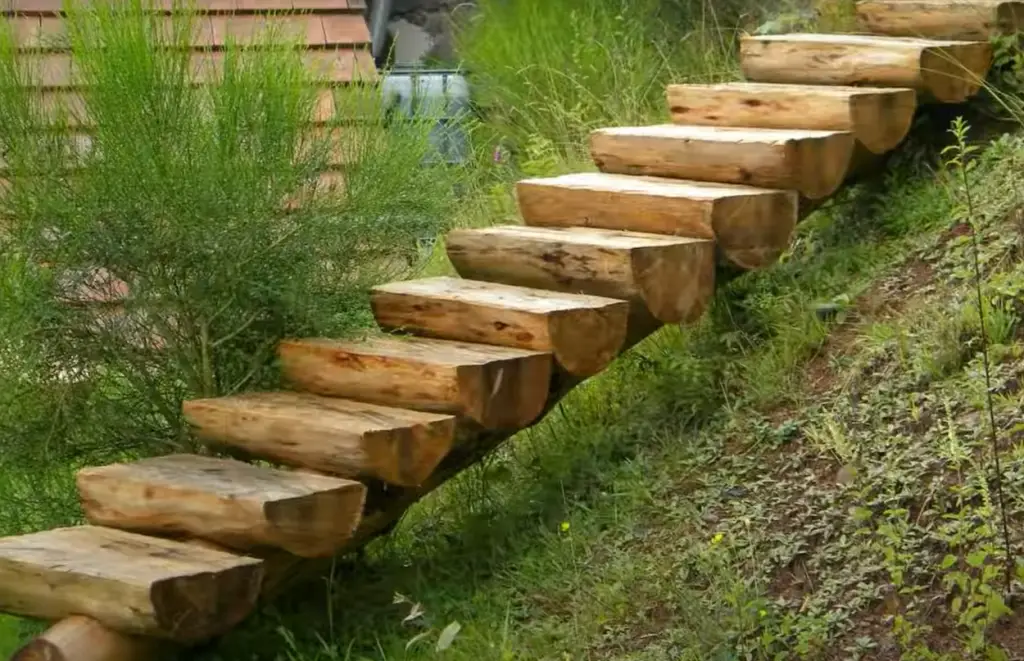
It’s also more affordable than other materials, and it’s easy to maintain. You may have to seal the concrete periodically to prevent staining and cracking.
Ideas on Incorporating Garden Stairs
Once you’ve decided what material to use for your garden stairs, it’s time to get creative! Here are some ideas for incorporating them into your landscape:
- Incorporate the steps into a rock wall or raised flower bed.
- Line the stairs with potted plants or trailing vines.
- Build a deck at the top of the stairs for a seating area.
- Add an archway or pergola over the stairs for shade.
- Use bright colours to make them stand out in your garden.
Consider Your Garden’s Overall Design
Before you start building, take a look at the overall design of your garden. Think about how the steps will fit into the existing landscape and how they’ll look when viewed from different angles.
This can help you determine what materials to use and which design elements to incorporate into your stairs.
Add Garden Step Lights
Adding lights to your garden steps is a great way to create an inviting atmosphere in the evening. You can use solar-powered LED lights for a cost-effective option, or you can go with battery-operated lights if you want something more decorative.
Add Plants to Your Garden Steps
Adding plants to your garden steps can add a touch of colour and life to the area. Use trailing vines or small shrubs along the sides of the stairs. You can also plant flowers in pots at each step for an added splash of colour.
Add Decorative Handrails
If your garden steps are more than a few feet high, it’s a good idea to install handrails for safety. You can use wood or metal for the handrails, but you can also get creative with design elements like looped scrolls or carved figures.
Add Patterned Tiles
Adding patterned tiles to the steps is a great way to add some visual interest. You can use single-coloured tiles with geometric shapes or brightly coloured tiles with intricate designs. This can create a unique look for your garden stairs and make them stand out in the landscape.
Other Garden Steps Ideas
Building garden steps doesn’t have to be a complicated process. Here are some other ideas to consider:
- Use timber sleepers or railway sleepers to create a unique look for your stairs.
- Add a raised planter box at the top of the stairs for added interest and colour.
- Incorporate a water feature at the top of the stairs, such as a small pond or fountain.
- Paint the steps in a bold colour to make them stand out in your garden.
- Add built-in seating along the sides of the stairs for an inviting spot to relax and enjoy the view.
- With these garden steps ideas, you can create a beautiful and functional space in your garden. Whether you’re looking for an easy way to add colour or a more complex landscape feature, there are plenty of ideas to explore.
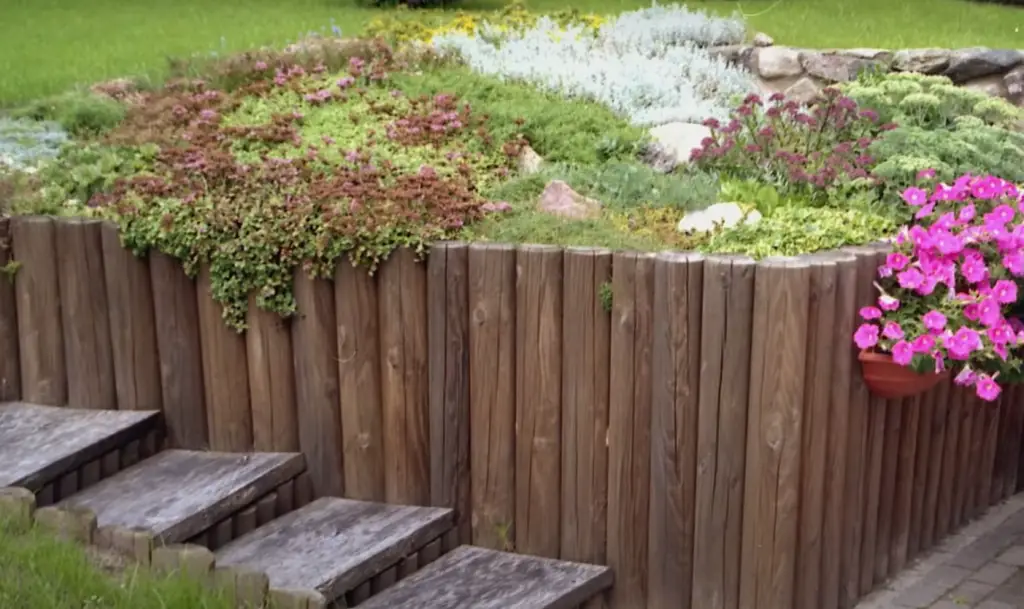
With the right materials and design elements, you can create a unique look that will be the focal point of your garden.
Tips for Building Garden Stairs
When planning your garden steps, there are a few things to keep in mind. Here are some tips for building garden stairs:
- Make sure the steps are wide enough for comfortable foot traffic.
- Keep the rise and run of the steps consistent throughout.
- Allow for drainage by creating a slight slope on each step.
- Use non-slip materials on the steps, like textured concrete or rough pavers.
- Securely anchor handrails and other fixtures to prevent wobbling or movement.[1]
FAQ
How to make cheap garden steps?
If you’re looking for an inexpensive option, use wooden sleepers or railway sleepers to create the steps. You can also use pavers, flagstones or concrete slabs on top of the wood for more stability and added traction.
How to make garden steps safe?
Adding handrails is an important safety consideration when building garden steps. If you’re using timber sleepers, use metal posts and rails to ensure a secure fit and prevent wobbling over time. Adding non-slip materials to the steps can also help improve the safety of your stairs.
How much does it cost to build garden stairs?
The cost of building garden stairs will depend on the materials used and the size of the project.
Generally, you can expect to spend anywhere from a few hundred dollars for a basic set of steps to several thousand dollars for more complex designs with added features.
What can I use instead of garden steps?
If you’re looking for an alternative to steps, consider creating a ramp or sloped pathway instead. This can be more practical for those with mobility issues, and it can also add an interesting design element to your garden.
What is the best height for garden steps?
The best height for garden steps will depend on the space you have available and the grade of the slope. Generally, it’s recommended to keep each step at 2-3 inches high with a 10-inch run (depth). This will provide comfortable footing while allowing enough room for drainage.
Do garden steps need an overhang?
If your garden steps are made of wood, it’s important to add an overhang of at least 3-4 inches.
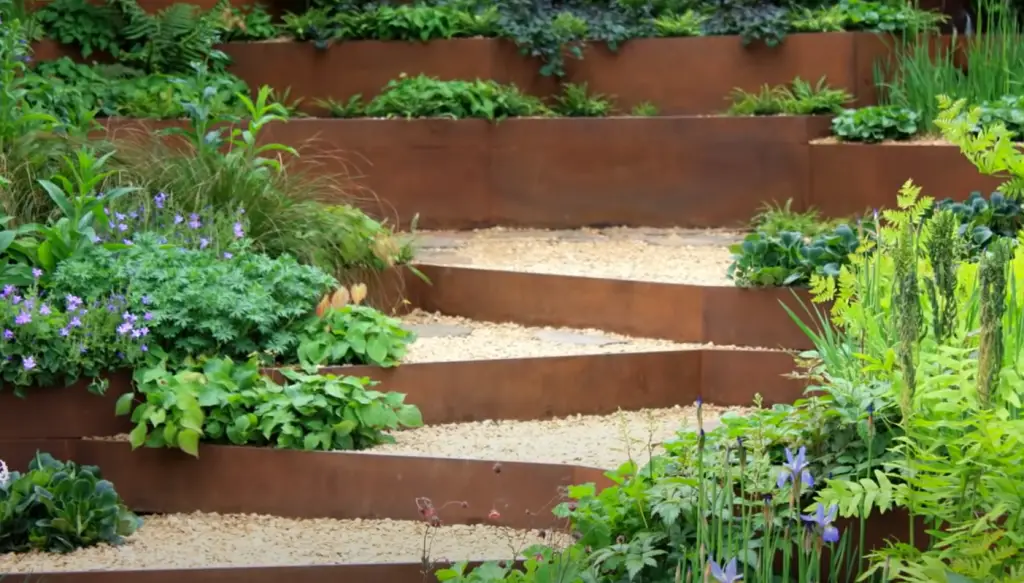
This will help protect the steps from rain and snow and prevent water from pooling on top of them.
What is a comfortable step size?
The most comfortable step size is usually between 8-12 inches in width and 2-3 inches in height. This will provide enough room for your foot to fit comfortably while still allowing for adequate drainage.
What is the most comfortable step height?
The most comfortable step height is usually between 2-3 inches. This will provide enough support and stability while walking up or down the stairs.
What type of material should I use for garden steps?
When building garden steps, it’s important to choose materials that are both durable and slip-resistant. Natural stone pavers and slabs, textured concrete and rough flagstones provide the best combination of traction and stability.
What type of handrail should I use?
When adding a handrail to your garden steps, it’s important to choose one that is both secure and aesthetically pleasing.
Metal or wooden posts with metal railing are popular options, as they provide the most stability while still looking great. If you’re using wood, seal the posts and railings to protect them from the elements.
What types of plants look best around garden steps?
There are many beautiful plants that can be planted around garden steps to add colour, texture and life.
Climbing vines such as English ivy, clematis and jasmine are great for creating a lush look; low-growing shrubs like boxwood and lavender provide an evergreen feel; and colourful annuals such as pansies, petunias and marigolds bring a cheerful look.
What other features can I add to garden steps?
In addition to handrails, there are many other features you can incorporate into your garden steps.
Lights along the sides or at the bottom of each step will provide a warm and inviting look; stone benches tucked into an alcove between steps offer seating for visitors; and planters set on either side of the steps add a touch of greenery.
What are some design ideas for garden steps?
Garden steps come in all shapes and sizes, so there’s plenty of room to get creative with your design.
Try installing curved or staggered steps for an interesting look; combining different materials such as brick, stone and concrete for a unique texture; or adding an outdoor sculpture at the top of the steps.
How do I maintain my garden steps?
Regular maintenance is key to keeping your garden steps in top shape. Periodically check for any cracking, crumbling or damage and repair as needed.
Sweep away leaves and debris, and regularly apply a sealant to protect the material from water damage. Finally, keep an eye out for weeds growing between the steps and take steps to keep them at bay.
How can I make garden steps safer?
There are several ways to improve the safety of your garden steps. Install lights along the sides or at the bottom of each step; add a handrail that is securely fastened to the stairs; and choose materials that provide traction and stability, such as slate, rough flagstone or textured concrete.

Additionally, it’s important to keep the area around the steps clear of debris and ice, and periodically check for any signs of damage. By taking these precautions, you can ensure your garden steps are both beautiful and safe.
How can I add personality to my garden steps?
Garden steps are the perfect way to express your personal style and make your outdoor space unique.
Add a sculpture at the top of the stairs for a dramatic effect; install lights along each step for an inviting look; or paint the handrails in bright colours for a fun, whimsical touch.
How can I make my garden steps stand out?
There are many ways to make your garden steps stand out from the rest. Try combining different materials for a unique look; installing lights along the side or at the bottom of each step; adding a sculpture at the top; or painting the handrails in bright colours. Whatever you choose, your garden steps will be sure to make a statement.
How can I make my garden steps more inviting?
Adding lights along the side or at the bottom of each step will create a warm, welcoming atmosphere. Incorporating features such as stone benches, planters and sculptures will also lend an inviting feel to your garden steps.
Finally, choosing materials that provide traction and stability will help ensure that visitors feel safe and comfortable.
What tips should I keep in mind when designing garden steps?
When designing garden steps, it’s important to consider the size and shape of your space, as well as any safety concerns.
Choose materials that provide traction and stability; incorporate lights for an inviting atmosphere; and add features such as handrails, stone benches and planters to make the steps more attractive.
Additionally, be sure to regularly maintain your garden steps in order to keep them looking their best.
How can I make my garden steps more functional?
In addition to making them aesthetically pleasing, you can also make your garden steps more functional.
Adding lights along the side or at the bottom of each step will allow for easier navigation; installing stone benches between the steps provides seating for visitors; and adding planters on either side allows for a touch of greenery. By incorporating these features, you can make sure your garden steps serve both form and function.
Why is maintenance important for garden steps?
Regular maintenance is essential to keeping your garden steps in top shape. Periodically check for any cracking, crumbling or damage and repair as needed. Sweep away leaves and debris, and regularly apply a sealant to protect the material from water damage.
Finally, keep an eye out for weeds growing between the steps and take steps to keep them at bay. By taking these simple steps, you can ensure that your garden steps remain in beautiful condition for years to come.
Why is proper drainage important for garden steps?
Proper drainage is essential to the long-term health of your garden steps. If water pools around the sides or at the bottom of each step, it can weaken the material and lead to cracking or crumbling over time.
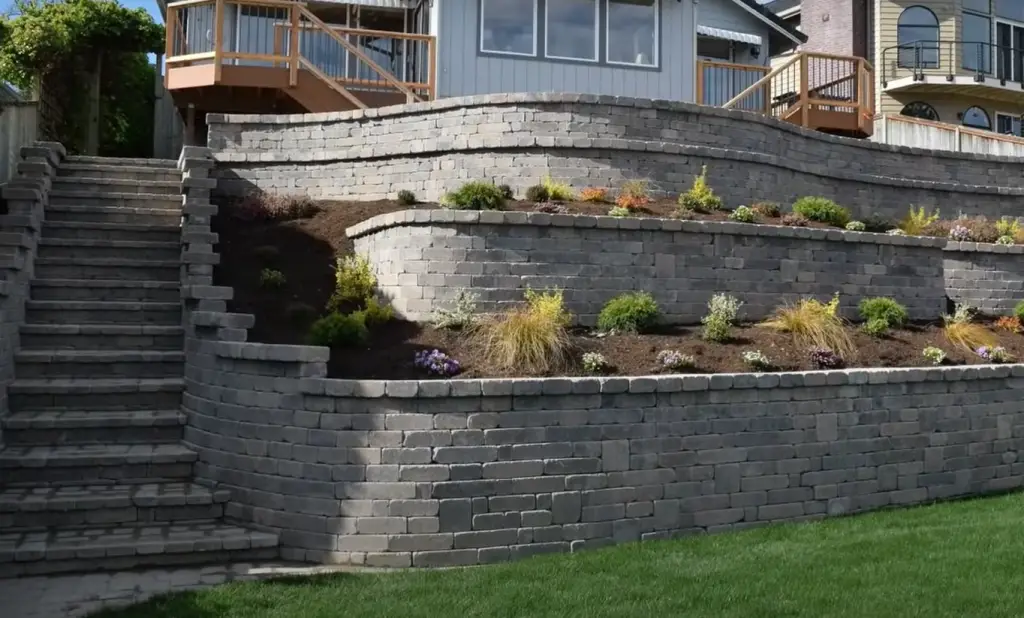
To avoid this, make sure that there’s a gentle slope away from the steps and that the area around them is clear of debris and weeds. Additionally, install a drainage system to ensure that excess water is properly diverted away from the steps.
Why is safety important for garden steps?
Safety should always be a top priority when it comes to designing and building garden steps.
Choose materials that provide adequate traction and stability; install handrails along each step; position lights on either side of the stairs for greater visibility; and ensure that there’s a gentle slope away from the steps.
Does the size of garden steps matter?
Yes, the size of your garden steps matters when it comes to both safety and aesthetics. The width, depth and height should be proportionate to the space they’re occupying; if they’re too large or small, they can look out of place.
Additionally, make sure that each step has enough room to comfortably accommodate visitors.
Do I need to install a handrail for my garden steps?
It’s always a good idea to install a handrail for your garden steps, especially if the space is used by children or elderly visitors. The handrail should be securely attached and extend the length of each step.
Additionally, choose materials that provide an adequate grip and check them regularly for any wear and tear.
Can I incorporate other features into my garden steps?
Yes! There are many ways to add an extra dimension of beauty and functionality to your garden steps.
Furthermore, add a layer of gravel or small stones between each step to create an inviting atmosphere and provide added traction.
Does the material I use for garden steps matter?
Yes, the materials you choose for your garden steps will have an impact on both their longevity and appearance.
Natural stone, brick or concrete are all popular choices; however, if you’re looking for something more unique, there are several other options such as wood, gravel or even mosaics.
Do garden steps need to be maintained?
Yes, just like any other outdoor feature, garden steps require regular maintenance. Sweep away leaves and debris, check for any signs of damage, and apply a sealant to protect the material from water damage.
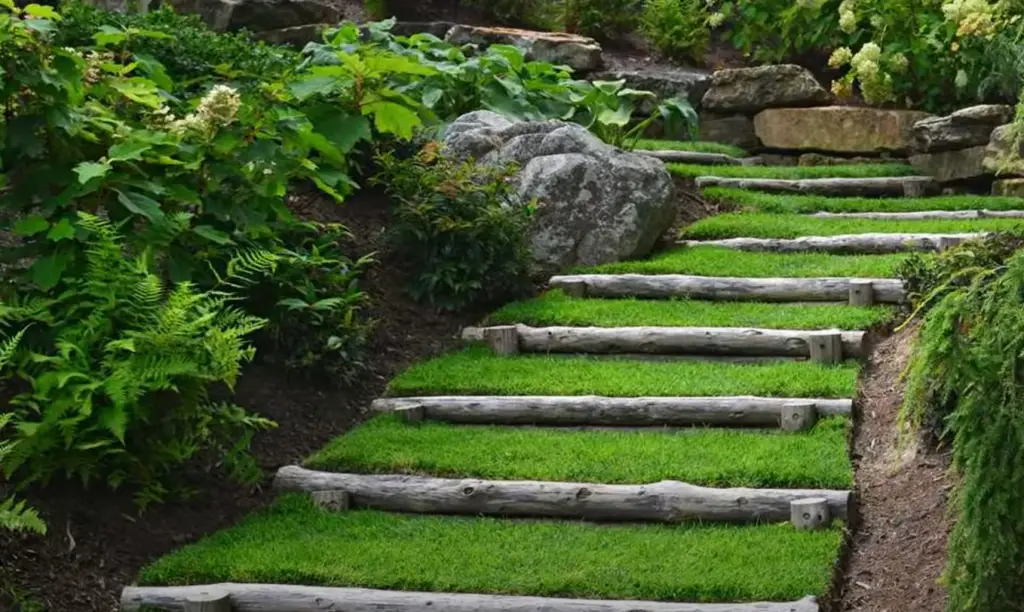
Additionally, keep an eye out for weeds growing between the steps and take action to prevent them from taking hold. With the right care, your garden steps will remain in beautiful condition for many years to come.
Does the design of garden steps matter?
Yes, the design of your garden steps can have a big impact on the overall look and feel of your outdoor space. Consider incorporating curves or inclines into your design for added interest or create multiple tiers with different materials for a more dynamic look.
Additionally, you can use lighting to draw attention to certain features and create a beautiful effect. With the right design, your garden steps can become an eye-catching centrepiece for your landscape.
Do I need to install a drainage system for my garden steps?
Yes, it’s a good idea to install a drainage system for your garden steps in order to prevent excess water from gathering around them. A well-designed drainage system will direct water away from the steps and help keep them looking their best.
Does the slope of garden steps matter?
Yes, it’s important to make sure that your garden steps have a gentle slope away from them.
This will help prevent water from pooling around them and allow for better drainage. Additionally, be sure to leave enough space between each step so visitors can comfortably move up and down them.
Do I need Council approval to build garden steps?
It depends on the size and scope of your project, but in some cases you may need to obtain council approval before beginning any building work.
Check with your local authority for more information about their requirements; they can provide guidance on the necessary paperwork as well as advise you on any regulations that may apply.
Does the size of garden steps matter?
Yes, it’s important to choose the right size for your garden steps. Consider who will be using them and install a step height that is comfortable and not too steep.
Additionally, leave enough space between each step so users can easily move up and down them without any difficulty. The width of the steps should also be taken into account; aim for a width of at least 36 inches so visitors have plenty of room to pass.
Do I need to use a professional for garden steps installation?
It depends on the complexity of your project, but it is generally recommended that you enlist the help of a professional in order to ensure the best possible results.
A qualified professional will have experience and expertise in creating beautiful, safe, and long-lasting garden steps. They can assess your outdoor space and offer advice on the most suitable design, materials, and installation techniques.
Can I use recycled materials for garden steps?
Yes, it’s possible to use recycled materials such as wood or bricks for your garden steps. Bear in mind that the condition of these materials may not be perfect, so you should inspect them carefully before purchasing and factor in any additional work that may be required.
Additionally, you can also reuse existing materials from around your property if they are in good condition – this can be a great way to add some character to your garden steps.
Can I use garden steps as seating?
Yes, garden steps can be used as seating by adding a bench or cushions. This is a great way to make your outdoor space more inviting and can provide extra seating for gatherings with family and friends.
However, it’s important to ensure that the steps are strong enough to support the weight of any seating as well as the people using it. If in doubt, always consult a professional for advice.
Can I paint garden steps?
Yes, you can paint your garden steps to give them a makeover. Make sure to choose paint suitable for outdoor use and keep in mind that the colour should complement the rest of your landscaping.
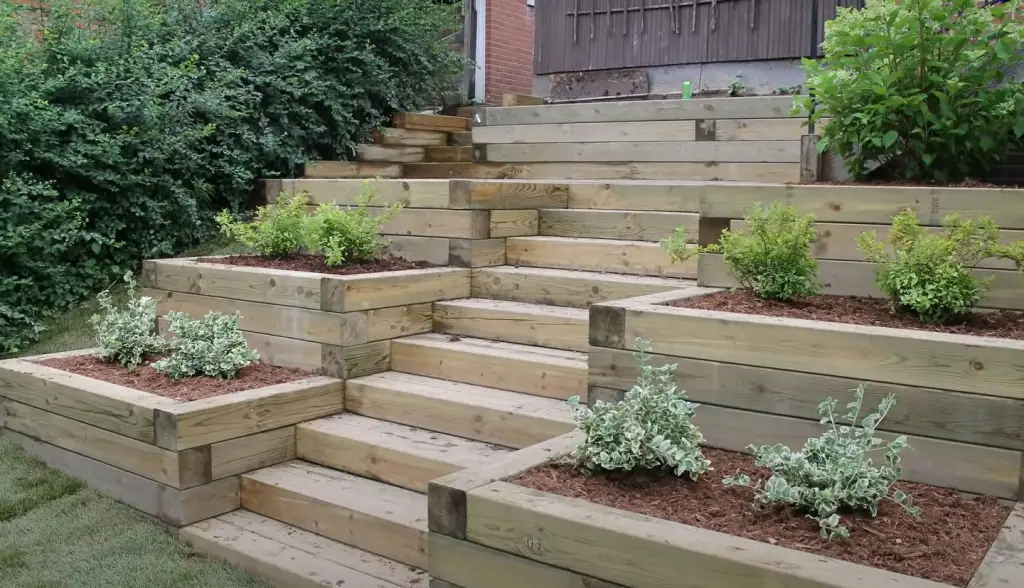
When painting, it’s important to prepare the surface properly; this includes cleaning it and sanding down any rough edges. This will ensure that the paint is properly adhered and lasts for many years.
Which materials are best for garden steps?
The most popular materials for garden steps include wood, concrete and stone. Wood is less expensive and can be easily cut to size, but will require regular maintenance in order to keep it looking its best.
Concrete is a great option as it’s durable, easy to install and cost effective; however, it can be difficult to work with. Stone is a timeless choice and will add an elegant touch to your outdoor space, but is usually more expensive than other materials.
Consider all the options carefully before deciding on the best material for your project.
Which safety features should I consider for garden steps?
Garden steps should be designed and built with safety in mind. Non-slip surfaces are essential; this can be achieved by using materials such as rubber, stone, or textured concrete.
Additionally, you may wish to add a handrail on at least one side of the stairs which should not be more than 34 inches above the step. This will help to provide extra stability and make it easier for users to move up and down the steps.
Is there anything else I need to consider for garden steps?
Yes, lighting is an important consideration when it comes to garden steps. This helps to make your outdoor space more inviting and can be used both during the day and at night.
Consider adding solar-powered lights or LED strips along the sides of your steps; this will create a beautiful soft glow and make it easier to find your way around your outdoor space in the dark.
Are there any tips for maintaining garden steps?
Regular maintenance is important in order to keep your garden steps looking their best. This includes checking the condition of the materials, cleaning and removing any debris, and repairing any damage as soon as it’s spotted.
Additionally, you should also be sure to check the stability of your steps regularly; this will help to avoid any accidents or injuries.
Useful Video: Steps and stairs in a sloping garden | Landscape Stairs Ideas 2022 | front yard stairs Design |
Conclusion
To summarise, garden steps can be a great way to add an attractive and functional feature to your outdoor space. However, it’s important to consider the design carefully and select materials that are suitable for your project.
Additionally, you should also keep in mind safety features such as non-slip surfaces and handrails as well as regular maintenance in order to ensure that your garden steps are safe and long-lasting.
With a little planning, you can create beautiful and inviting garden steps for years to come!
References:
- https://www.airtasker.com/gardening/garden-designers/guides/garden-steps-ideas/





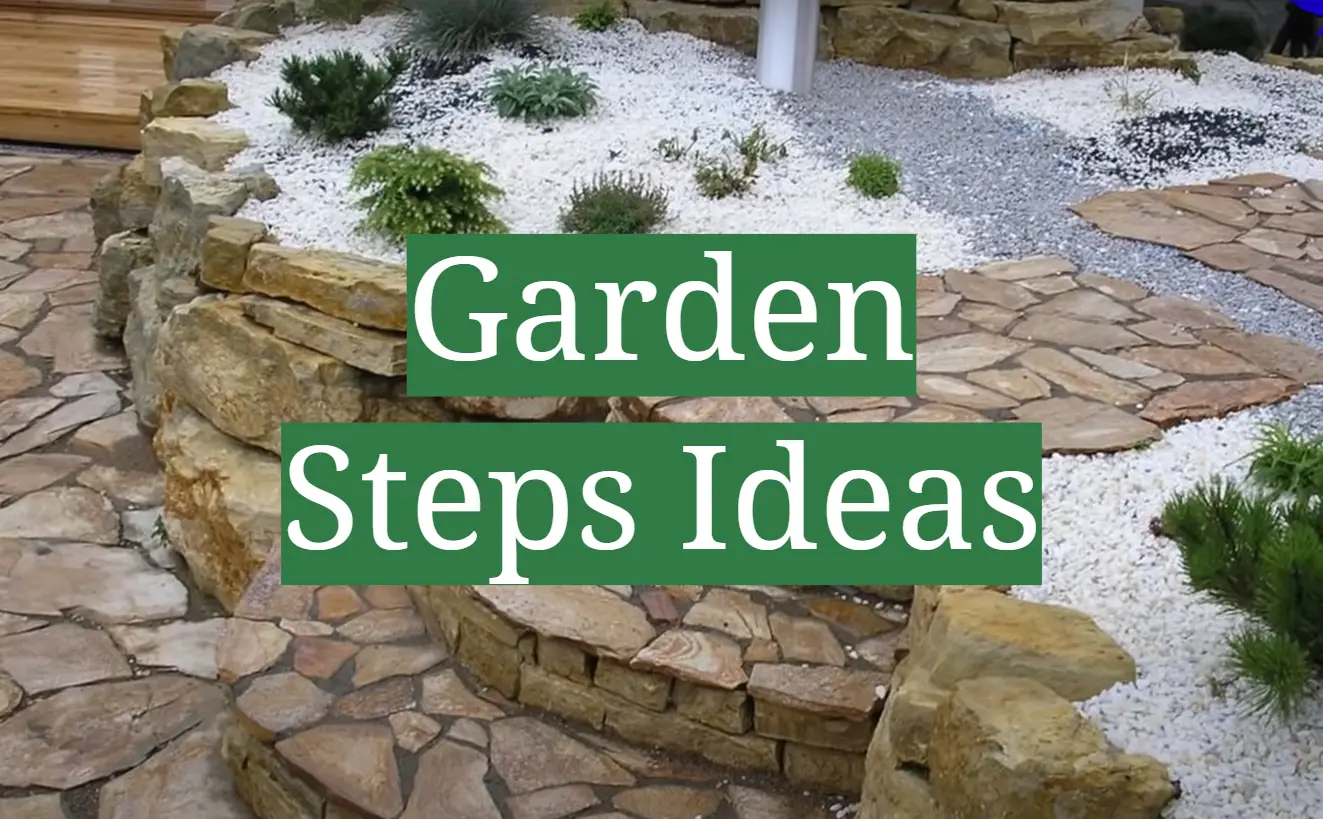




Leave a Reply
View Comments